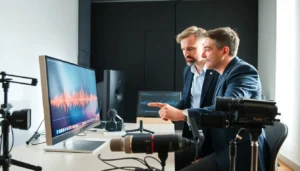Imagine a world without sound—no chirping birds, no laughter, and definitely no catchy tunes to hum along to. Auditory sensors are the unsung heroes that make this vibrant soundscape possible. These incredible little devices, whether in our ears or embedded in technology, play a crucial role in how we perceive and interact with our environment.
From helping us enjoy our favorite music to enabling life-saving communication devices, auditory sensors are everywhere, quietly working their magic. They translate vibrations into sounds, making the invisible audible. So, next time you’re grooving to your favorite playlist or enjoying a heartfelt conversation, take a moment to appreciate the science behind those sounds. After all, without auditory sensors, life would be a whole lot quieter—and let’s be honest, who wants that?
Table of Contents
ToggleOverview Of Auditory Sensors
Auditory sensors play a crucial role in perceiving and interpreting sound. These sensors transform sound waves into electrical signals, enabling individuals to process auditory information effectively.
Definition And Function
Auditory sensors are specialized biological or technological receptors dedicated to detecting sound. In humans, hair cells within the cochlea serve as auditory sensors, converting mechanical vibrations from sound waves into neural signals. These signals travel through the auditory pathway to the brain, where they’re interpreted as recognizable sounds. Devices like microphones also operate as auditory sensors, capturing sound waves and converting them into digital signals for analysis or playback.
Importance In Various Fields
Auditory sensors contribute significantly across multiple domains. In healthcare, they aid in diagnosing hearing impairments, making early detection possible. In communication technology, auditory sensors enhance listening devices, improving accessibility for users. The entertainment industry relies on these sensors to create immersive audio experiences, enriching music and film consumption. In robotics, auditory sensors enable machines to interact with their environments, following voice commands or localizing sound sources.
Types Of Auditory Sensors

Auditory sensors fall into two main categories: microphones and biological auditory sensors. Each type plays a significant role in sound perception and processing.
Microphones
Microphones serve as technological auditory sensors by capturing sound waves. Various designs exist, including dynamic, condenser, and ribbon microphones. The dynamic microphone utilizes electromagnetic induction, making it durable and versatile for live performances. In contrast, condenser microphones excel in studio settings due to their sensitivity and ability to capture nuanced sounds. Ribbon microphones offer a vintage sound quality, ideal for specific genres. Applications extend beyond music to include sound recording, broadcasting, and surveillance, showcasing microphones’ essential contributions to audio technology.
Biological Auditory Sensors
Biological auditory sensors, such as hair cells in the inner ear, interpret sound waves. Within the cochlea, these hair cells transform mechanical vibrations into electrical signals, facilitating auditory processing. Humans typically possess about 15,000 hair cells, each responding to different frequencies. Damage to these cells can lead to hearing impairments or loss, emphasizing their critical function. Research into hair cell regeneration holds promise for restoring hearing. Moreover, understanding these biological sensors informs advancements in auditory prosthetics, enhancing communication for individuals with hearing challenges.
Applications Of Auditory Sensors
Auditory sensors play a significant role across various sectors, enhancing functionality and experiences in everyday life. Their applications range from consumer electronics to healthcare advancements.
Consumer Electronics
Consumer electronics utilize auditory sensors to enhance user experiences. Devices like smartphones and smart speakers rely on microphones to capture sound, ensuring clear voice recognition and effective communication. Users benefit from features such as voice assistants that utilize auditory sensors for seamless interaction. Sound systems, equipped with advanced microphones and speakers, deliver high-fidelity audio, transforming music listening into an immersive experience. Furthermore, gaming consoles integrate auditory sensors to create realistic soundscapes, providing gamers with an enriched atmosphere during gameplay.
Healthcare
Healthcare significantly benefits from auditory sensors in diagnosing and treating hearing impairments. Audiologists employ specialized auditory assessments to gauge hearing sensitivity through advanced equipment. Cochlear implants, devices designed to restore hearing, rely on auditory sensors to convert sound into electrical signals directly stimulating the auditory nerve. These innovations allow individuals with hearing loss to experience sounds again. Ongoing research aims to improve these technologies, emphasizing the regeneration of hair cells, which may further advance treatments for auditory deficiencies.
Challenges And Innovations
Auditory sensors face various challenges and innovations driving their development. Technological improvements often encounter limitations impacting their effectiveness.
Technical Limitations
Sensitivity to background noise presents a significant challenge for auditory sensors. Devices frequently struggle to distinguish between desired sounds and disruptive interference. Battery life also limits the practicality of many sensor systems, particularly in portable devices. Connectivity issues hinder the seamless integration of auditory sensors with other technologies, reducing their overall performance. In some cases, the processing speed for sound analysis falls short, impacting real-time applications.
Recent Advancements
Recent advancements in auditory sensor technology focus on enhancing performance and expanding capabilities. Researchers explore machine learning algorithms to improve sound recognition accuracy. Noise-canceling technologies are becoming more sophisticated, allowing for clearer audio in crowded environments. Innovations in miniaturization enable the development of smaller, more efficient microphones with better sound capture abilities. Additionally, bioengineering efforts seek to regenerate hair cells, providing potential solutions for hearing restoration. Collaborative projects between technology firms and audiologists emphasize the need for specialized applications, enhancing user experience across various domains.
Auditory sensors are integral to how individuals engage with their surroundings. They not only enhance communication but also enrich experiences in entertainment and technology. As advancements continue in both biological and technological realms, the potential for improving sound perception and accessibility grows.
The ongoing research into hair cell regeneration and innovations in microphone technology promises exciting developments. These efforts will likely lead to better auditory solutions for those facing hearing challenges. By understanding and appreciating the role of auditory sensors, society can foster a more inclusive environment where everyone can enjoy the sounds of life.







